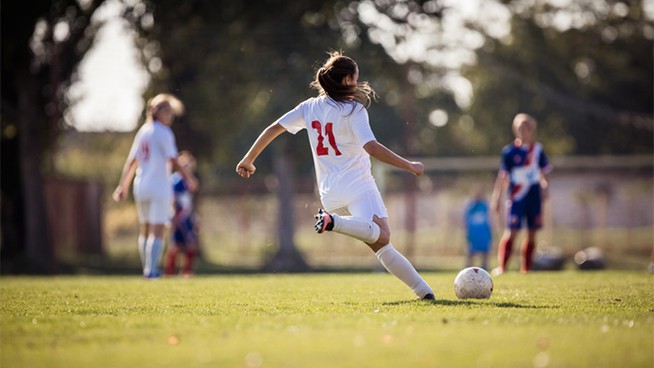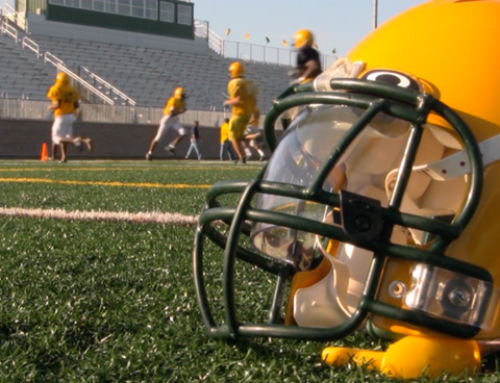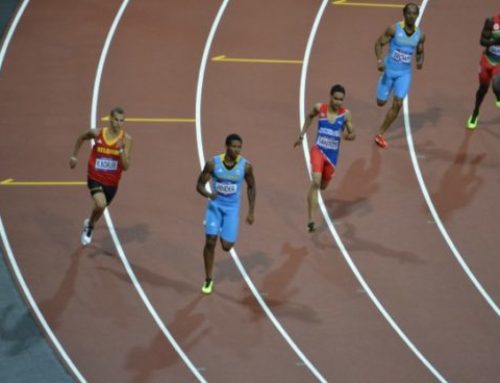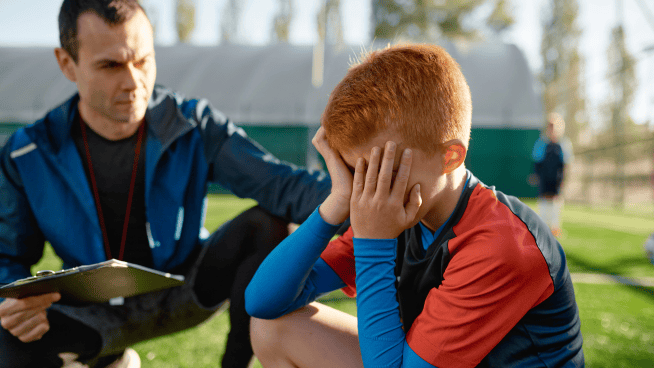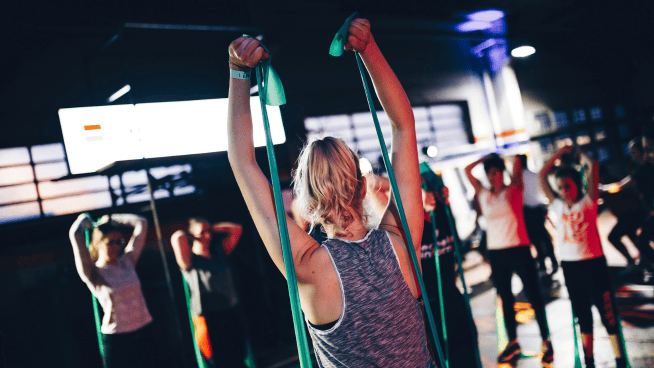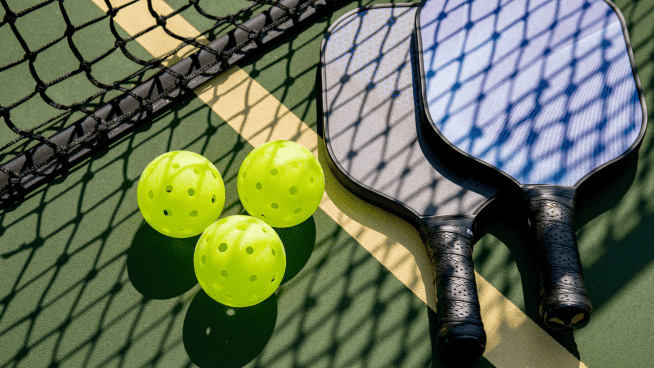5 Ways Field Athletes Can Get Faster
How many times have you, as an athlete, been just one step behind an opponent who outran you, or just one second too late for a chance, a shot, a pass?
Seemingly everyone’s first reaction to such a situation is a socially less-acceptable variation of “oh no!” and the second one is “wow, need to be faster next time.”
Everybody needs more speed.
That is not up for debate, as there are few sports that do not rely on power and speed!
Field sports like soccer, baseball, American football, hockey and basketball obviously require speed and power as an entry point for the game.
Less commonly considered sports like table tennis, cheerleading, Olympic weightlifting, ballet, swimming and diving, tennis, and badminton all demand power and speed as well. As these sports are more technical, however, speed and power may not present themselves the same way as in field sports, where opponents face off against each other and the faster one usually wins that moment-long duel. But these skills are most certainly needed!
So how DO we get faster?
As a performance coach for mostly field sports, I may be biased, but many experts in our field seem to agree:
Speed is perhaps most purely expressed in its truest form—sprinting.
Sprinting is one of the most aggressive things the body can do. It’s also a “hindbrain” activity, meaning your thinking brain—the “executive” or prefrontal cortex, literally the front part of your head—needs to be turned off to do it well. Sprinting is a natural, instinctual feat. This seems perhaps like a contradictory dilemma: If you should not think while sprinting, but you are not already fast, how can one get faster?
Before we address how to increase speed, let us break down the common ways we keep ourselves from it.
How Not to Get Faster
“The more, the better” is not true when sprinting. Because expressions of speed and power—sprinting being the purest expression of this—is exhausting to the central nervous system (CNS), less is actually more.
Overdoing conditioning work will not help you get faster. Wearing yourself down with high doses of speed and power work, called “high CNS fatigue,” is not a good plan either; it just make you tired and sweaty, and not want to train tomorrow. At the same time, training at a low intensity or effort is clearly not beneficial for speed gains!
Contrary to some “sport experts,” permanently breaking up with strength training also does not result in more speed. Neglecting your recovery, diet and sleep is also detrimental to improvement, as the nervous system must recover for the body to heal and repeat speed and power skills.
Lastly, one surefire way to keep yourself from increasing speed and power is to not listen to your coach. If your coach is competent and you have discussed your need for speed, then athletes need to buy into their knowledge and trust the plan. Adding or skipping sets and even workouts is definitely not going to bring quick returns!
How to Get Faster
Sprint Fast and Often
Does this seem counterintuitive? Did I not just say that, in fact, less is more? The primary message here is to, above all else, be consistent in a speed program and manage your volume according to your training and competition schedule.
Sprinting more often—increasing speed sessions to twice a week from once a week, for example—can certainly help you get faster. However, that does not mean you should lace up and sprint 15 sets of 40 yards at 100% effort every day of the week. That is too much!
It does mean that you should purposefully vary your sprint workouts across different distances, at different velocities, at different levels of effort, with a phase focused on Acceleration in the first 10 steps and a phase of Maximum Velocity. This calculated, purposeful training will make maximum-effort sprints in games much more manageable when the body is used to completing them several times a week.
The central nervous system is sensitive but it can also adapt incredibly well with the right amount of stress and recovery. Starting to sprint more often and in a controlled environment that allows rest, instead of just in competition, is a great way to improve the body’s ability to run faster with less effort and more often.
Train at Appropriate Intensity
Although similar to the last point, it is worth reiterating: To get fast, you do not need to sprint at maximum effort for 100 reps per day. But when you do sprint, you need to make it count.
Again, listening to a competent coach and program is important. Does your workout say 90-95% effort on 5 sets of 20m today? Or is it 5x30m at 70%? Either way, all reps need to be focused and executed with proper technique, with appropriate rest between, and hitting that prescribed intensity every time.
It does not take a high dose or a million reps of sprinting to make an athlete fast. It just takes many small, intense, well-timed and recoverable doses.
Lift
Do not stop lifting weights.
In working with teams as a performance coach, I have heard every variation of “I’ve never seen an athlete get faster by lifting weights” and “weights make you slow and heavy!”
Although the equation Speed + Weights = Heavier Player = Less Speed may appear to pass the logic test, it skips over some key factors.
If lifting weights makes you slow, you are lifting wrong. Strength training for performance sport is not bodybuilding or powerlifting; those kinds of lifting do indeed add mass and restrict mobility, which can make an athlete slow.
By the time you are in the preparation and competition phases, when you need speed and power, your “strength phase” is over. You do not need to be lifting maximally four times per week or put on mass with intense soreness after every workout.
Mass makes athletes slow. But lifting weights does not necessarily equate to adding mass!
Another complaint I hear regarding strength training and speed is that athletes are too tired to be fast after lifting.
This equation does make sense.
Every stress we put on the body, including training, taxes the CNS. Some movements and types of lifts tax the CNS more than others, such as Olympic lifting—that’s why you do not need very many repetitions in a session. The Shoulder Press, though, is a low-CNS movement—if you complete 3 sets of 6 reps, you might be a little gassed, but you will not be wiped out on the floor as if you Clean-and-Jerked 3×6.
But that is not the only way to lift weights!
Lifting with speed can help.
Heavy lifting to maintain maximal strength is important, as are hamstring-specific accessory lifts to keep your legs in top condition for sprinting. Depending on your sport and its demands, you can also work on upper-body lifts because this will not tax your nervous system heavily enough to detract from your speed gains.
However, lifting below your 1-Rep Max, around 60-70%, and moving at a higher velocity is essentially “weighting” your speed in the gym, with the goal of moving faster when the weights come off.
There are also other training methods of getting faster, such as ballistic training and the ever-famed plyometrics. A competent coach knows how to program these into a speed and strength program so that all exercises contribute to your power, velocity and resilience.
Power training—sprinting, throwing, jumping—and speed lifts should come before the lifts in a workout. You do not need to stop going to the gym to get fast, but do not spend your whole week there powerlifting either.
The Other Stuff
This might sound basic, but you need to focus on your recovery. Again, speed requires a healthy, regenerated, and adaptive CNS. That means between workouts you need quality sleep, appropriate food intake and to keep your stress low. Just keep your recovery a high priority.
Listen to Your Coach
Speed training has to fit into your training schedule, right?
If you are just out there sprinting every day with no guidance or idea of how to progress, the truth is that you will get slower because you are tired, taking on too much training volume. This translates to the CNS as stress—throughout your whole week with games and training sessions—and not recovering enough to improve speed in games.
If your strength or speed coach is competent, it is worth listening to him or her and trusting the program. They know how to manage your body’s stress and fatigue, your load, and how it all fits together with the rest of your performance.
Final Thoughts
Speed is awesome, and everybody needs it. It is a requirement for most sports!
It also seems like gaining speed should be easy and intuitive, but it actually is not!
Speed and power are very fine balances that require attention to fine details—your CNS, your recovery and your schedule.
Always keep in mind the following tips, which I hope make speed training more accessible to you:
- Sprint, jump and throw more often, but know that less is also more!
- Sprinting is perhaps the best tool for training speed and power.
- Take your recovery seriously. Speed and power training is hard on the CNS, and regeneration time is when you heal and adapt.
- Continue lifting. Weights do not make you slow; they make you strong and resilient.
- Listen to your coach! They wrote your program that way for a reason.
Good luck, and sprint hard!
Editor’s Note: A version of this article by Julia Eyre was previously published by White Lion Performance.
Photo Credit: simonkr/iStock
READ MORE:
RECOMMENDED FOR YOU
MOST POPULAR
5 Ways Field Athletes Can Get Faster
How many times have you, as an athlete, been just one step behind an opponent who outran you, or just one second too late for a chance, a shot, a pass?
Seemingly everyone’s first reaction to such a situation is a socially less-acceptable variation of “oh no!” and the second one is “wow, need to be faster next time.”
Everybody needs more speed.
That is not up for debate, as there are few sports that do not rely on power and speed!
Field sports like soccer, baseball, American football, hockey and basketball obviously require speed and power as an entry point for the game.
Less commonly considered sports like table tennis, cheerleading, Olympic weightlifting, ballet, swimming and diving, tennis, and badminton all demand power and speed as well. As these sports are more technical, however, speed and power may not present themselves the same way as in field sports, where opponents face off against each other and the faster one usually wins that moment-long duel. But these skills are most certainly needed!
So how DO we get faster?
As a performance coach for mostly field sports, I may be biased, but many experts in our field seem to agree:
Speed is perhaps most purely expressed in its truest form—sprinting.
Sprinting is one of the most aggressive things the body can do. It’s also a “hindbrain” activity, meaning your thinking brain—the “executive” or prefrontal cortex, literally the front part of your head—needs to be turned off to do it well. Sprinting is a natural, instinctual feat. This seems perhaps like a contradictory dilemma: If you should not think while sprinting, but you are not already fast, how can one get faster?
Before we address how to increase speed, let us break down the common ways we keep ourselves from it.
How Not to Get Faster
“The more, the better” is not true when sprinting. Because expressions of speed and power—sprinting being the purest expression of this—is exhausting to the central nervous system (CNS), less is actually more.
Overdoing conditioning work will not help you get faster. Wearing yourself down with high doses of speed and power work, called “high CNS fatigue,” is not a good plan either; it just make you tired and sweaty, and not want to train tomorrow. At the same time, training at a low intensity or effort is clearly not beneficial for speed gains!
Contrary to some “sport experts,” permanently breaking up with strength training also does not result in more speed. Neglecting your recovery, diet and sleep is also detrimental to improvement, as the nervous system must recover for the body to heal and repeat speed and power skills.
Lastly, one surefire way to keep yourself from increasing speed and power is to not listen to your coach. If your coach is competent and you have discussed your need for speed, then athletes need to buy into their knowledge and trust the plan. Adding or skipping sets and even workouts is definitely not going to bring quick returns!
How to Get Faster
Sprint Fast and Often
Does this seem counterintuitive? Did I not just say that, in fact, less is more? The primary message here is to, above all else, be consistent in a speed program and manage your volume according to your training and competition schedule.
Sprinting more often—increasing speed sessions to twice a week from once a week, for example—can certainly help you get faster. However, that does not mean you should lace up and sprint 15 sets of 40 yards at 100% effort every day of the week. That is too much!
It does mean that you should purposefully vary your sprint workouts across different distances, at different velocities, at different levels of effort, with a phase focused on Acceleration in the first 10 steps and a phase of Maximum Velocity. This calculated, purposeful training will make maximum-effort sprints in games much more manageable when the body is used to completing them several times a week.
The central nervous system is sensitive but it can also adapt incredibly well with the right amount of stress and recovery. Starting to sprint more often and in a controlled environment that allows rest, instead of just in competition, is a great way to improve the body’s ability to run faster with less effort and more often.
Train at Appropriate Intensity
Although similar to the last point, it is worth reiterating: To get fast, you do not need to sprint at maximum effort for 100 reps per day. But when you do sprint, you need to make it count.
Again, listening to a competent coach and program is important. Does your workout say 90-95% effort on 5 sets of 20m today? Or is it 5x30m at 70%? Either way, all reps need to be focused and executed with proper technique, with appropriate rest between, and hitting that prescribed intensity every time.
It does not take a high dose or a million reps of sprinting to make an athlete fast. It just takes many small, intense, well-timed and recoverable doses.
Lift
Do not stop lifting weights.
In working with teams as a performance coach, I have heard every variation of “I’ve never seen an athlete get faster by lifting weights” and “weights make you slow and heavy!”
Although the equation Speed + Weights = Heavier Player = Less Speed may appear to pass the logic test, it skips over some key factors.
If lifting weights makes you slow, you are lifting wrong. Strength training for performance sport is not bodybuilding or powerlifting; those kinds of lifting do indeed add mass and restrict mobility, which can make an athlete slow.
By the time you are in the preparation and competition phases, when you need speed and power, your “strength phase” is over. You do not need to be lifting maximally four times per week or put on mass with intense soreness after every workout.
Mass makes athletes slow. But lifting weights does not necessarily equate to adding mass!
Another complaint I hear regarding strength training and speed is that athletes are too tired to be fast after lifting.
This equation does make sense.
Every stress we put on the body, including training, taxes the CNS. Some movements and types of lifts tax the CNS more than others, such as Olympic lifting—that’s why you do not need very many repetitions in a session. The Shoulder Press, though, is a low-CNS movement—if you complete 3 sets of 6 reps, you might be a little gassed, but you will not be wiped out on the floor as if you Clean-and-Jerked 3×6.
But that is not the only way to lift weights!
Lifting with speed can help.
Heavy lifting to maintain maximal strength is important, as are hamstring-specific accessory lifts to keep your legs in top condition for sprinting. Depending on your sport and its demands, you can also work on upper-body lifts because this will not tax your nervous system heavily enough to detract from your speed gains.
However, lifting below your 1-Rep Max, around 60-70%, and moving at a higher velocity is essentially “weighting” your speed in the gym, with the goal of moving faster when the weights come off.
There are also other training methods of getting faster, such as ballistic training and the ever-famed plyometrics. A competent coach knows how to program these into a speed and strength program so that all exercises contribute to your power, velocity and resilience.
Power training—sprinting, throwing, jumping—and speed lifts should come before the lifts in a workout. You do not need to stop going to the gym to get fast, but do not spend your whole week there powerlifting either.
The Other Stuff
This might sound basic, but you need to focus on your recovery. Again, speed requires a healthy, regenerated, and adaptive CNS. That means between workouts you need quality sleep, appropriate food intake and to keep your stress low. Just keep your recovery a high priority.
Listen to Your Coach
Speed training has to fit into your training schedule, right?
If you are just out there sprinting every day with no guidance or idea of how to progress, the truth is that you will get slower because you are tired, taking on too much training volume. This translates to the CNS as stress—throughout your whole week with games and training sessions—and not recovering enough to improve speed in games.
If your strength or speed coach is competent, it is worth listening to him or her and trusting the program. They know how to manage your body’s stress and fatigue, your load, and how it all fits together with the rest of your performance.
Final Thoughts
Speed is awesome, and everybody needs it. It is a requirement for most sports!
It also seems like gaining speed should be easy and intuitive, but it actually is not!
Speed and power are very fine balances that require attention to fine details—your CNS, your recovery and your schedule.
Always keep in mind the following tips, which I hope make speed training more accessible to you:
- Sprint, jump and throw more often, but know that less is also more!
- Sprinting is perhaps the best tool for training speed and power.
- Take your recovery seriously. Speed and power training is hard on the CNS, and regeneration time is when you heal and adapt.
- Continue lifting. Weights do not make you slow; they make you strong and resilient.
- Listen to your coach! They wrote your program that way for a reason.
Good luck, and sprint hard!
Editor’s Note: A version of this article by Julia Eyre was previously published by White Lion Performance.
Photo Credit: simonkr/iStock
READ MORE:


